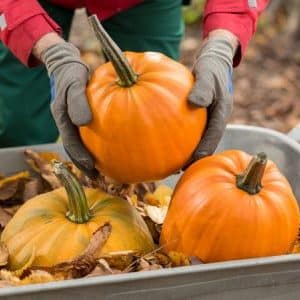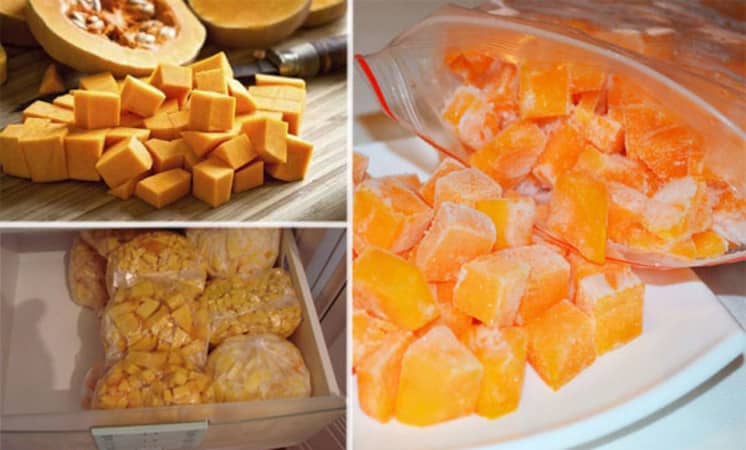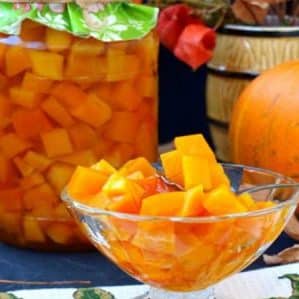How to store cut pumpkin at home: the best methods and periods for storing fresh vegetables
Pumpkin is a storehouse of useful microelements and vitamins. The vegetable is suitable for baby food and is considered dietary. But its large size often poses a problem: how to store a cut pumpkin so as not to lose its valuable properties? Let's look at the best ways.
Varieties for long-term storage
Late-ripening varieties are most suitable for long-term storage at home. The thick and elastic peel allows you to maintain the integrity of the vegetable without loss of microelements, fiber and vitamins for a long time.
In addition, pumpkin is divided into small and large-fruited varieties. The latter have a longer shelf life - up to 8 months. Small-fruited ones are not as persistent (only 3-4 months), but have a more pronounced and pleasant taste.

The following varieties are best preserved:
- Kherson – large fruit weighing 3–6 kg. Has a sweet taste.
- Slavuta – a large-fruited variety that ripens towards the end of the season. The pumpkin, up to 3.5 kg in size, has a sweet taste, loose texture and deep orange flesh.
- Zhdana. Reaches 6-8 kg. Sweet, with richly colored pulp.
- Arbatskaya – a nutmeg variety with dense, sweet pulp. The peel has a light gray coating. Stored until the next harvest.
- Donskaya - a juicy pumpkin, distinguished by its gray with shades of green peel color. If the storage temperature does not exceed 15°C, it can last up to 70 weeks.
- Hylea - a large vegetable (at least 9 kg) of the muscat variety with crispy and firm flesh of a bright color.Keeps in the refrigerator for 12 months.
- Polyanin – an oblong fruit weighing up to 4 kg with firm and juicy pulp. At a temperature of 18°C it is stored for a year.
- Ioannina – mid-ripening fruit weighing 6.5 kg. The juicy pulp can retain its beneficial properties until the next harvest.
Preliminary preparation and storage conditions
Vegetables should be harvested from the beds only after they are fully ripe. It is impossible to keep the pumpkin until it freezes, because frozen fruits will quickly rot at home. A late-ripening vegetable with a strong crust without visible damage is ideal for storage.
Advice. It is recommended to pick pumpkins on a sunny day. The fruit is separated from the vines with a knife, leaving the stalk behind (without it, the pumpkin will begin to rot).
To ensure that the pumpkin lasts throughout the winter, it is left under a canopy in the sun for a week, allowing the skin to harden and dry.
Damaged fruits (with dents, scratches, traces of rot) are set aside for short-term storage and consumption first. The rest are transferred to a prepared place - a dry and cool room with a storage temperature of 10°C (but not lower than 1°C) and a humidity of 60–70%.

To successfully store vegetables, three important conditions must be met:
- maintain a stable temperature;
- Avoid exposure to direct sunlight;
- Avoid contact of vegetables with each other.
Cut, peeled pumpkin should only be stored in the refrigerator. Pieces wrapped in film or foil will last from two weeks to a month. Frozen slices will keep for up to a year. Outside of the freezer, sliced pumpkin will last 2-3 days.
How to properly store pumpkin - whole, peeled or cut
The storage method depends on the amount of harvest and the location.For home owners, a basement or cellar is preferable. In an apartment, a refrigerator, a glassed-in balcony, and a cool pantry are suitable for wintering vegetables. Some particularly resistant varieties can be preserved at room temperature.
On the balcony
To store a pumpkin on the balcony, you need to choose only a glazed and insulated room. The temperature should remain in the range of +2...+15°C, and humidity should not exceed 75%.
The fruits are placed on wooden racks, having previously laid thick paper or thick fabric on them. Vegetables are placed in one layer with the stalks facing up. Be sure to leave space between them so that the fruits do not touch. The top of the pumpkin harvest is covered with a cloth, protecting it from sunlight.
Sliced pumpkin is stored in such conditions for 2-3 days.
Advice. In winter, the fruits should be covered with a warm blanket to prevent the pumpkin from freezing. If there is not enough space on the balcony and the vegetables need to be placed more tightly, you need to separate them with cardboard or thick paper.
In the cellar

Cellar room or basement must meet the following conditions: dryness, good ventilation and temperature range +2...+10°C.
You can cover the racks with straw, sawdust or pine needles, and then place the fruits on them in one row with the stalks up and at a distance from each other. Or hang pumpkins in nets from the ceiling.
In a refrigerator
The refrigerator is the best place to store cut vegetables at home. Procedure:
- Wash the pumpkin, remove the seeds and core, and let it dry.
- Cut into pieces in any convenient way.
- Cover the fruit with cling film or pack it in a bag or container and put it in the refrigerator.
The shelf life of pumpkin in this form is 10-15 days.
In the freezer

The freezer will help you stock up on cut pumpkin for the winter, in which the vegetable will retain its valuable properties and brightness of taste. The size of the pieces is determined independently. After cutting the fruit, the pieces are placed in containers or bags for freezing.
Shelf life: more than six months. If the temperature is below 18°C, the pumpkin can last a whole year.
In the apartment
If there is no balcony, a pantry or living room is suitable for storing pumpkin crops. The main condition: the place must be dark, dry, not too warm or cold (away from radiators).
Temperature and shelf life
The optimal temperature for storing pumpkin is +5...+15°C. With it, vegetables remain juicy until spring - early summer.
The longest shelf life – 12 months – is provided by the freezer. This applies to both whole fruit and sliced fruit.
The second important indicator is humidity (60–70%) and shading of the room (no direct sunlight).
Alternative methods

If all of the above methods are not suitable, you can turn to alternative ones.
Drying
If there is no space in the apartment to store fresh fruits, pumpkin is recommended dry:
- Wash and cut the vegetables.
- Remove the peel and discard the seeds.
- Cut the pulp into slices 0.5–1 cm thick.
- Place them in a colander and plunge into boiling water for 1-2 seconds. Then immediately transfer to ice water.
- Drain the colander, place the plates on the table and let them dry.
- Place on a baking sheet and place in a preheated oven (50-60°C) for 5-6 hours.
- Place the dried pumpkin in a container with a tight lid. Store in a dark and dry place (for example, in a pantry).

Pickling
A convenient and easy way to store pumpkins - pickling:
- First remove the skin and get rid of the seeds.
- Cut into small pieces and place them in a sterilized jar.
- Fill with cool water to the brim.
- Season generously with salt and cover tightly. Store in a dark place.
Conclusion
Only the refrigerator (10-15 days) and the freezer (more than six months) are suitable for storing chopped, peeled pumpkin. The best solution would be to store the pumpkin in its entirety on the balcony or in the cellar.
In order for the vegetable to retain its taste and beneficial properties, you must strictly observe the temperature regime, humidity level and avoid direct sunlight.